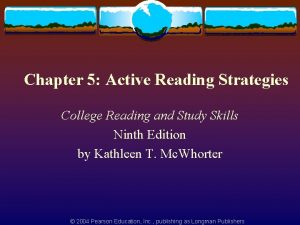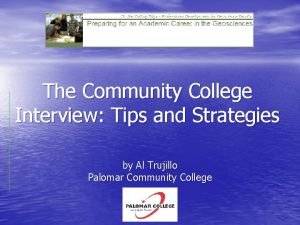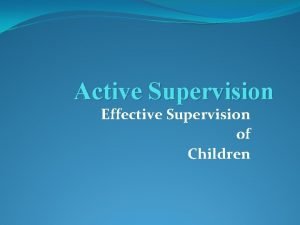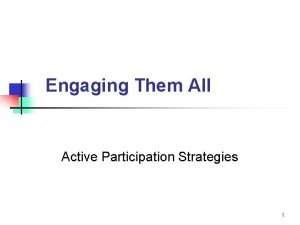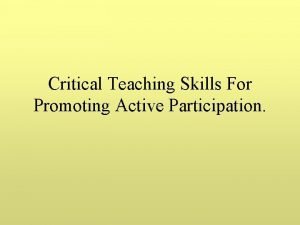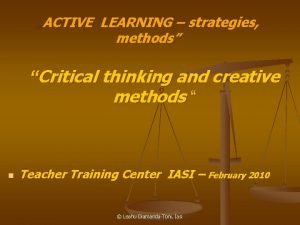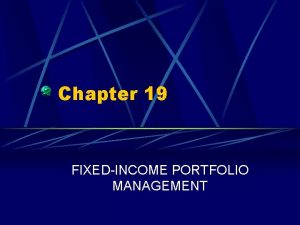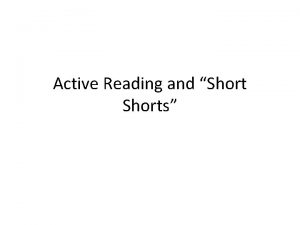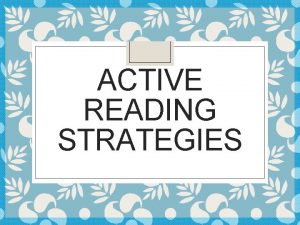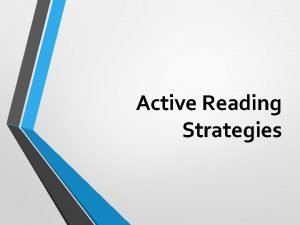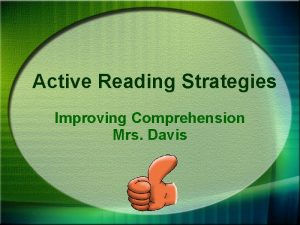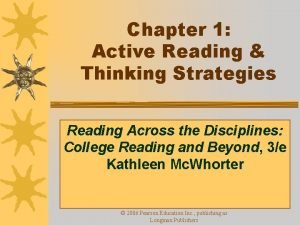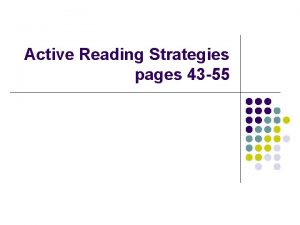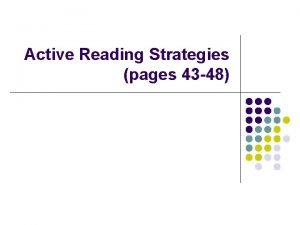Chapter 5 Active Reading Strategies College Reading and












- Slides: 12

Chapter 5: Active Reading Strategies College Reading and Study Skills Ninth Edition by Kathleen T. Mc. Whorter © 2004 Pearson Education, Inc. , publishing as Longman Publishers

Objectives: This chapter will demonstrate techniques to help you decide what to learn in a textbook chapter. v You will learn to preread before reading, to discover what you already know about the topic, and to define your purposes for reading. v You will learn to monitor and strengthen your comprehension as you read. v LEARNING PRINCIPLE: We all remember what we intend to remember. v © 2004 Pearson Education, Inc. , publishing as Longman Publishers

How to Preread 1. 2. 3. 4. 5. 6. 7. Read the title and subtitle. Read the introduction or first paragraph. Read each major heading. Read the first sentence under each heading. Note any typographical and graphical aids. Read the last paragraph or summary. Read quickly any end-of-article or end-of-chapter material. © 2004 Pearson Education, Inc. , publishing as Longman Publishers

Why Prereading Works 1. It helps you get interested in and involved with what you will read by activating your thinking. 2. It provides you with a mental outline of the material you are going to read. 3. It lets you apply several principles of learning. You identify what is important, thus establishing an intent to remember. 4. It functions as rehearsal that enhances recall because it provides repetition of the most important points. © 2004 Pearson Education, Inc. , publishing as Longman Publishers

Making Predictions 1. Making predictions is a way to expand broaden your thinking beyond the Knowledge and Comprehension levels. 2. Predicting forces you to apply your knowledge to new situations (Application, Analysis, and Synthesis). 3. Efficient readers make predictions about organization and content. 4. As efficient readers read, they confirm, reject, or revise their initial predictions. © 2004 Pearson Education, Inc. , publishing as Longman Publishers

How to Discover What You Already Know 1. Ask questions and try to answer them. 2. Relate the topic to your own experience. 3. Free-associate everything that comes to mind. © 2004 Pearson Education, Inc. , publishing as Longman Publishers

Define Your Purpose for Reading Develop Guide Questions: v Who? v What? v When? v Where? v Why? v How? © 2004 Pearson Education, Inc. , publishing as Longman Publishers

Checking Your Comprehension v Recognize v Evaluate Comprehension Signals Your Comprehension 1. Set checkpoints. 2. Use your guide questions. 3. Ask connection questions. 4. Use internal dialogue. See Figure 5. 4 in your book for positive and negative comprehension signals. © 2004 Pearson Education, Inc. , publishing as Longman Publishers

How to Strengthen Your Comprehension 1. Analyze the time and place in which you are reading. 2. Rephrase each paragraph in your own words. 3. Read aloud sentences or sections that are particularly difficult. 4. Reread difficult or complicated sections. 5. Slow down your reading rate. © 2004 Pearson Education, Inc. , publishing as Longman Publishers

How to Strengthen Your Comprehension 1. 2. 3. 4. 5. Write guide questions next to headings. Write a brief outline of major points. Highlight key ideas. Write notes in the margins. Determine whether you lack background knowledge. © 2004 Pearson Education, Inc. , publishing as Longman Publishers

Summary Questions 1. What is prereading? 2. How do you preread? 3. Why is it helpful to make predictions about materials you are preparing to read? 4. Why is discovering what you already know valuable to do before reading? 5. How can you define a purpose for reading? 6. How can you keep track of comprehension while reading? © 2004 Pearson Education, Inc. , publishing as Longman Publishers

Take a Reading Road Trip! Take a trip to NEW ORLEANS and visit the Active Reading module on your CD-ROM. © 2004 Pearson Education, Inc. , publishing as Longman Publishers
 5 active reading strategies
5 active reading strategies Visualize reading strategy
Visualize reading strategy Pre reading while reading and post reading activities
Pre reading while reading and post reading activities Boolean operators
Boolean operators Primary active transport and secondary active transport
Primary active transport and secondary active transport By listening to my inner defender voice i can be sure that
By listening to my inner defender voice i can be sure that College interview tips and strategies
College interview tips and strategies Active learning strategies to promote critical thinking
Active learning strategies to promote critical thinking What does active supervision mean
What does active supervision mean Different kinds of choral speaking
Different kinds of choral speaking Promoting active participation
Promoting active participation Active learning strategies to promote critical thinking
Active learning strategies to promote critical thinking Active fixed income portfolio management strategies
Active fixed income portfolio management strategies
